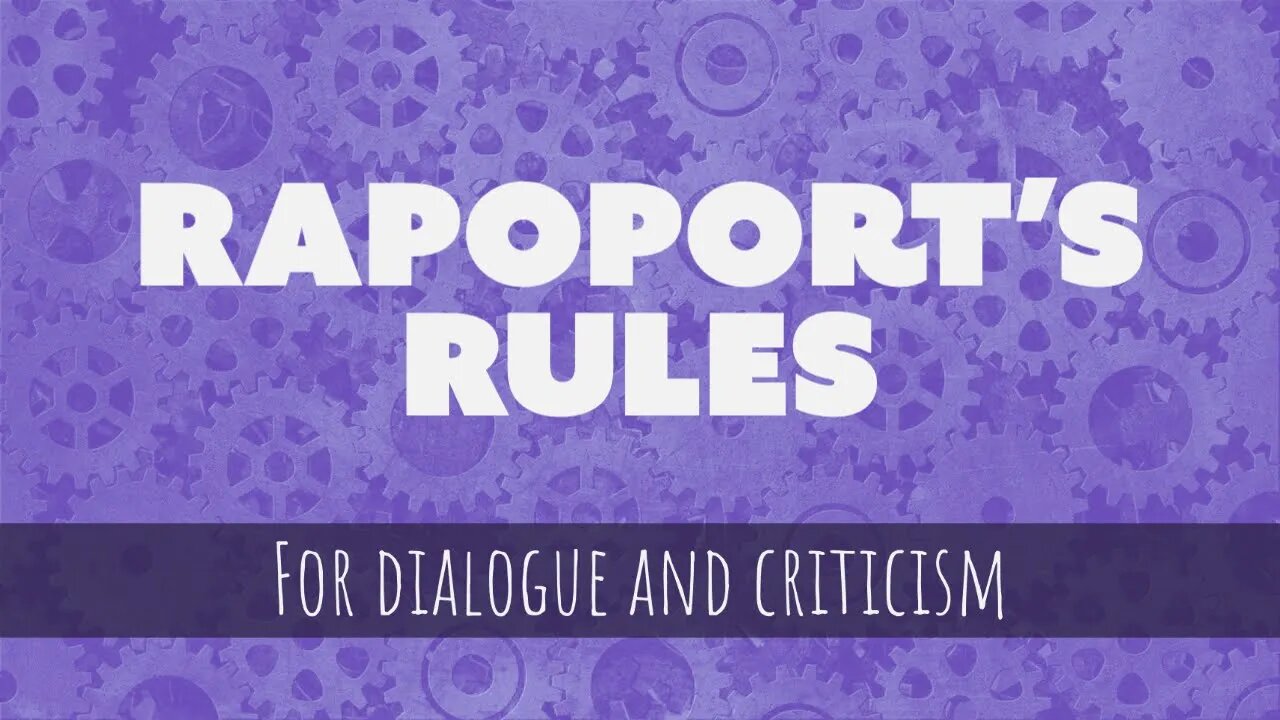Premium Only Content

Rapoport's Rules for Dialogue and Criticism
"Just how charitable are you supposed to be when criticizing the views of an opponent? If there are obvious contradictions in the opponent’s case, then you should point them out, forcefully. If there are somewhat hidden contradictions, you should carefully expose them to view—and then dump on them. But the search for hidden contradictions often crosses the line into nitpicking, sea-lawyering and outright parody. The thrill of the chase and the conviction that your opponent has to be harboring a confusion somewhere encourages uncharitable interpretation, which gives you an easy target to attack. But such easy targets are typically irrelevant to the real issues at stake and simply waste everybody’s time and patience, even if they give amusement to your supporters. The best antidote I know for this tendency to caricature one’s opponent is a list of rules promulgated many years ago by social psychologist and game theorist Anatol Rapoport (creator of the winning Tit-for-Tat strategy in Robert Axelrod’s legendary prisoner’s dilemma tournament).
How to compose a successful critical commentary:
1. You should attempt to re-express your target’s position so clearly, vividly, and fairly that your target says, “Thanks, I wish I’d thought of putting it that way.”
2. You should list any points of agreement (especially if they are not matters of general or widespread agreement).
3. You should mention anything you have learned from your target.
4. Only then are you permitted to say so much as a word of rebuttal or criticism.
One immediate effect of following these rules is that your targets will be a receptive audience for your criticism: you have already shown that you understand their positions as well as they do, and have demonstrated good judgment (you agree with them on some important matters and have even been persuaded by something they said)."
- Daniel Dennett, Intuition Pumps and Other Tools for Thinking
-
 2:05:35
2:05:35
The White House
6 hours agoPresident Trump Hosts a Reception Honoring Black History Month
64.7K36 -
 1:05:09
1:05:09
Josh Pate's College Football Show
6 hours ago $0.40 earnedCFP Expansion: Latest Intel | CFB’s Schedule Problem | Arch Manning Hype | ACC Program Rankings
15.6K2 -
 55:52
55:52
LFA TV
1 day agoTrump vs. Europe | TRUMPET DAILY 2.20.25 7PM
21K2 -
 31:02
31:02
Chrissy Clark
2 hours agoAn IVF Nightmare, Trump’s Illegal Immigration Crackdown, & Biden’s Student Loan Plan BLOCKED I URS
14.1K7 -
 1:02:57
1:02:57
In The Litter Box w/ Jewels & Catturd
1 day agoKASH CONFIRMATION TODAY! | In the Litter Box w/ Jewels & Catturd – Ep. 746 – 2/20/2025
118K71 -
 56:44
56:44
VSiNLive
4 hours ago $5.49 earnedFollow the Money with Mitch Moss & Pauly Howard | Hour 1
88.2K3 -
 1:08:41
1:08:41
John Crump Live
8 hours ago $2.49 earnedUSA v. Canada! Bigger Than Just A Game
41.4K6 -
 1:58:40
1:58:40
Revenge of the Cis
5 hours agoEpisode 1450: Wet Work
52.1K3 -
 3:36:29
3:36:29
vivafrei
11 hours agoKash Patel Confirmation Hearing LIVE! Jan. 6'er Kicked Out of CPAC? DOGE Wins in Court? & MORE!
270K304 -
 5:08:38
5:08:38
Barry Cunningham
11 hours agoTRUMP DAILY BRIEFING: KASH PATEL VOTE | WHITE HOUSE PRESS CONFERENCE | DOGE UPDATE
78.1K28